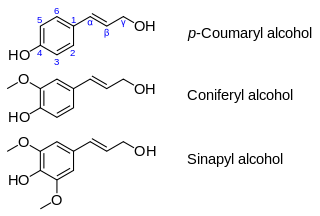
Lignin is a class of complex organic polymers that form key structural materials in the support tissues of most plants. Lignins are particularly important in the formation of cell walls, especially in wood and bark, because they lend rigidity and do not rot easily. Chemically, lignins are polymers made by cross-linking phenolic precursors.
In chemistry, stereoselectivity is the property of a chemical reaction in which a single reactant forms an unequal mixture of stereoisomers during a non-stereospecific creation of a new stereocenter or during a non-stereospecific transformation of a pre-existing one. The selectivity arises from differences in steric and electronic effects in the mechanistic pathways leading to the different products. Stereoselectivity can vary in degree but it can never be total since the activation energy difference between the two pathways is finite. Both products are at least possible and merely differ in amount. However, in favorable cases, the minor stereoisomer may not be detectable by the analytic methods used.
The lignans are a large group of low molecular weight polyphenols found in plants, particularly seeds, whole grains, and vegetables. The name derives from the Latin word for "wood". Lignans are precursors to phytoestrogens. They may play a role as antifeedants in the defense of seeds and plants against herbivores.

Podophyllotoxin (PPT) is the active ingredient in Podofilox, which is a medical cream that is used to treat genital warts and molluscum contagiosum. It is not recommended in HPV infections without external warts. It can be applied either by a healthcare provider or the person themselves.
Guaiacol is an organic compound with the formula C6H4(OH)(OCH3). It is a phenolic compound containing a methoxy functional group. Guaiacol appears as a viscous colorless oil, although aged or impure samples are often yellowish. It occurs widely in nature and is a common product of the pyrolysis of wood.

Dirigent proteins are members of a class of proteins which dictate the stereochemistry of a compound synthesized by other enzymes. The first dirigent protein was discovered in Forsythia intermedia. This protein has been found to direct the stereoselective biosynthesis of (+)-pinoresinol from coniferyl alcohol monomers:

The phenylpropanoids are a diverse family of organic compounds that are synthesized by plants from the amino acids phenylalanine and tyrosine. Their name is derived from the six-carbon, aromatic phenyl group and the three-carbon propene tail of coumaric acid, which is the central intermediate in phenylpropanoid biosynthesis. From 4-coumaroyl-CoA emanates the biosynthesis of myriad natural products including lignols, flavonoids, isoflavonoids, coumarins, aurones, stilbenes, catechin, and phenylpropanoids. The coumaroyl component is produced from cinnamic acid.

Syringol is the organic compound with the formula HO(CH3O)2C6H3. The molecule is a phenol, with methoxy groups in the flanking (2 and 6) positions. It is the symmetrically dimethylated derivative of pyrogallol. It is a colorless solid, although typical samples are brown owing to air-oxidized impurities. Together with guaiacol, syringol and its derivatives are produced by the pyrolysis of lignin. Specifically, syringol is derived from the thermal decomposition of the sinapyl alcohol component. As such, syringol is an important component of wood smoke.

Monolignols, also called lignols, are the source materials for biosynthesis of both lignans and lignin and consist mainly of paracoumaryl alcohol (H), coniferyl alcohol (G) and sinapyl alcohol (S). These monolignols differ in their degree of methoxilation of the aromatic ring.

Sinapyl alcohol is an organic compound structurally related to cinnamic acid. It is biosynthetized via the phenylpropanoid biochemical pathway, its immediate precursor being sinapaldehyde. This phytochemical is one of the monolignols, which are precursor to lignin or lignans. It is also a biosynthetic precursor to various stilbenoids and coumarins.
In enzymology, a dihydrokaempferol 4-reductase (EC 1.1.1.219) is an enzyme that catalyzes the chemical reaction

Cinnamoyl-CoA reductase (EC 1.2.1.44), systematically named cinnamaldehyde:NADP+ oxidoreductase (CoA-cinnamoylating) but commonly referred to by the acronym CCR, is an enzyme that catalyzes the reduction of a substituted cinnamoyl-CoA to its corresponding cinnamaldehyde, utilizing NADPH and H+ and releasing free CoA and NADP+ in the process. Common biologically relevant cinnamoyl-CoA substrates for CCR include p-coumaroyl-CoA and feruloyl-CoA, which are converted into p-coumaraldehyde and coniferaldehyde, respectively, though most CCRs show activity toward a variety of other substituted cinnamoyl-CoA's as well. Catalyzing the first committed step in monolignol biosynthesis, this enzyme plays a critical role in lignin formation, a process important in plants both for structural development and defense response.

Forsythia × intermedia, or border forsythia, is an ornamental deciduous shrub of garden origin.

Sinapaldehyde is an organic compound with the formula HO(CH3O)2C6H2CH=CHCHO. It is a derivative of cinnamaldehyde, featuring one hydroxy group and two methoxy groups as substituents. It is an intermediate in the formation of sinapyl alcohol, a lignol that is a major precursor to lignin.

Coniferyl aldehyde is an organic compound with the formula HO(CH3O)C6H3CH=CHCHO. It is a derivative of cinnamaldehyde, featuring 4-hydroxy and 3-methoxy substituents. It is a major precursor to lignin.

Pinoresinol is a tetrahydrofuran lignan found in Styrax sp., Forsythia suspensa, and in Forsythia koreana. It is also found in the caterpillar of the cabbage butterfly, Pieris rapae where it serves as a defence against ants.
Queen retinue pheromones (QRP) are a type of honey bee pheromones, so-called because one of their behavioral effects is to attract a circle of bees around the queen.
Eugenol synthase (EC 1.1.1.318, LtCES1, EGS1, EGS2) is an enzyme with systematic name eugenol:NADP+ oxidoreductase (coniferyl ester reducing). This enzyme catalyses the following chemical reaction: eugenol + a carboxylate + NADP+ a coniferyl ester + NADPH + H+
Isoeugenol synthase (EC 1.1.1.319, IGS1, t-anol/isoeugenol synthase 1) is an enzyme with systematic name eugenol:NADP+ oxidoreductase (coniferyl acetate reducing). This enzyme catalyses the following chemical reaction.















